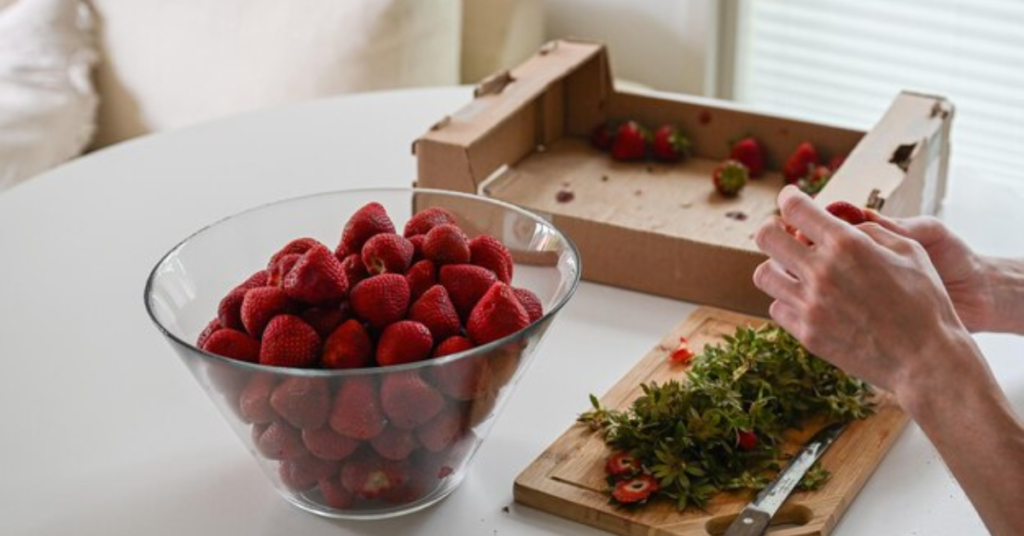Fruit salsa is a vibrant, refreshing, and versatile dish that pairs well with a variety of foods, from grilled meats to chips or even as a topping for desserts. It’s typically made using fresh fruits like tomatoes, mangoes, peaches, or strawberries, combined with savory ingredients like onions, cilantro, and lime. But what if you want to make fruit salsa with frozen strawberries? Can frozen strawberries work just as well as fresh ones?
In this article, we will explore the concept of using frozen strawberries to make fruit salsa, providing insights into how it affects texture, flavor, and preparation methods. We’ll also dive into creative ways to make the most of frozen strawberries, answer common questions, and explore alternative fruits for salsa-making.
What is Fruit Salsa?
Fruit salsa is a variation of the classic tomato-based salsa, with the key difference being that the main ingredient is fruit instead of vegetables. While tomato salsa tends to be savory and slightly tangy, fruit salsa leans towards a sweet and tangy flavor profile, making it perfect for pairing with both sweet and savory dishes. The beauty of fruit salsa lies in its versatility, as it can be adapted to suit a variety of fruits, seasonings, and textures.
The basic elements of a fruit salsa typically include:
- Fruit: Common fruits used in fruit salsas include strawberries, mangoes, peaches, pineapple, blueberries, and even watermelon. These fruits bring natural sweetness, juiciness, and vibrant colors to the dish.
- Seasonings: Just like traditional salsa, fruit salsa incorporates various seasonings to add depth and complexity. These can include cilantro, onions (red onion is a popular choice), jalapeños for heat, and lime juice for a tangy kick.
- Acid: Lime juice is the most commonly used acid, but lemon juice or vinegar can also be used depending on the flavor profile you desire.
Given how refreshing and adaptable fruit salsa can be, it’s an excellent choice for outdoor gatherings, barbecues, and even as a topping for dishes like grilled fish, chicken, or tacos.
Frozen Strawberries in Fruit Salsa: Can It Work?
Frozen strawberries are a convenient option when fresh strawberries are not in season or if you simply prefer to have them readily available in your freezer. But when it comes to using frozen strawberries in fruit salsa, there are some considerations to take into account. The primary differences between fresh and frozen strawberries are texture and moisture content. Here’s what you need to know:
1. Texture Differences Between Fresh and Frozen Strawberries
Frozen strawberries have a different texture than fresh ones due to the freezing process. When strawberries are frozen, the water inside their cells turns into ice crystals, which can rupture the cell walls. When thawed, frozen strawberries become softer and can release excess moisture, making them mushy compared to their fresh counterparts.
This change in texture can affect the overall consistency of your fruit salsa. A fresh strawberry will remain firm and hold its shape when mixed with other ingredients, while a thawed strawberry might break down into pieces or become too watery.
However, in the context of fruit salsa, the softer texture of thawed frozen strawberries can actually work to your advantage in some cases. If you don’t mind a slightly softer salsa with a more syrupy consistency, then frozen strawberries can be a great option. For those who prefer a more structured salsa, fresh strawberries may be a better choice.
2. Flavor Considerations
In terms of flavor, frozen strawberries are often just as sweet and tangy as fresh ones, assuming they were frozen at the peak of ripeness. However, freezing and thawing strawberries can sometimes cause a slight loss in flavor intensity. The fruit may also lose some of its fresh, bright notes and become a bit more subdued or watery. This is especially true if the strawberries were not frozen properly or were stored for an extended period.
However, because fruit salsa relies heavily on other ingredients like lime, cilantro, and onions, the flavor difference between fresh and frozen strawberries might not be significant enough to alter the final result dramatically.
3. Moisture Management
Frozen strawberries release more moisture when thawed, which can affect the texture of your salsa, making it too watery. To mitigate this, you may want to take extra steps to drain the strawberries before using them. One method is to thaw the strawberries, then gently press or blot them with a paper towel to absorb any excess liquid.
Another method is to use a colander to drain the thawed strawberries and allow the excess moisture to drain away. This step is particularly important if you are looking to make a thicker, chunkier salsa rather than a more liquidy, juice-laden one.
How to Make Fruit Salsa with Frozen Strawberries
Now that we’ve covered the primary considerations of using frozen strawberries in fruit salsa, let’s dive into the actual process. With a few simple steps, you can make a delicious fruit salsa with frozen strawberries that’s perfect for any occasion. Here’s a step-by-step guide:
Ingredients:
- 2 cups frozen strawberries (thawed and drained)
- 1 ripe mango, diced
- 1/2 cup red onion, finely diced
- 1/4 cup fresh cilantro, chopped
- 1 jalapeño pepper, finely diced (optional, for heat)
- 2 tablespoons fresh lime juice
- 1 tablespoon honey or agave syrup (optional, depending on sweetness preference)
- Salt and pepper to taste
Instructions:
- Thaw the Strawberries: Place the frozen strawberries in a bowl and let them thaw at room temperature for about 1-2 hours. Alternatively, you can speed up the process by microwaving them in short bursts. Once thawed, drain any excess water by placing them in a colander or pressing gently with a paper towel.
- Prepare the Other Ingredients: While the strawberries are thawing, dice the mango into small cubes, finely chop the red onion and cilantro, and mince the jalapeño (if using). Set aside.
- Mash the Strawberries (Optional): Once thawed and drained, give the strawberries a quick mash with a fork or potato masher to break them down slightly. If you prefer chunkier salsa, you can leave the strawberries in larger pieces.
- Combine the Ingredients: In a large mixing bowl, combine the thawed strawberries, diced mango, red onion, cilantro, and jalapeño. Add lime juice and stir to combine. Taste and adjust with salt, pepper, and honey (if needed) to suit your flavor preferences.
- Let It Sit: For the best flavor, cover the salsa and refrigerate it for at least 30 minutes before serving. This allows the flavors to meld together, resulting in a more cohesive and flavorful salsa.
- Serve: Serve the fruit salsa with tortilla chips, grilled chicken, fish tacos, or use it as a topping for desserts like cheesecake or ice cream.
Tips for Making the Best Fruit Salsa with Frozen Strawberries
- Use Fresh Lime Juice: The acidity of lime juice brightens up the salsa and balances the sweetness of the fruit. Fresh lime juice is always preferable to bottled lime juice for the best flavor.
- Control the Texture: To control the texture of your salsa, you can adjust how much you mash the strawberries. For a chunkier salsa, leave the strawberries in larger pieces. For a more liquidy salsa, mash the fruit more.
- Drain Excess Liquid: Since frozen strawberries release more moisture than fresh ones, be sure to drain them well before mixing with the other ingredients. This will prevent the salsa from becoming too watery.
- Add a Sweetener: If your strawberries are not as sweet as you’d like them to be, you can add a tablespoon of honey, agave syrup, or even a bit of maple syrup to bring out the natural sweetness of the fruit.
- Mix Up the Fruit: Experiment with other fruits like peaches, blueberries, or pineapple for added variety and flavor. You can also add diced tomatoes if you prefer a more traditional salsa base.
Variations of Fruit Salsa with Frozen Strawberries
While strawberries are often the star of fruit salsa, there are plenty of variations you can try. Here are a few ideas to switch things up:
- Peach and Strawberry Salsa: Add diced peaches to the strawberry salsa for an extra layer of sweetness and complexity.
- Pineapple Strawberry Salsa: Combine the tangy sweetness of pineapple with strawberries for a tropical twist.
- Spicy Strawberry Salsa: Add more jalapeños, or even a pinch of cayenne pepper, to amp up the heat in your salsa.
- Berry Mix Salsa: Combine strawberries, blueberries, and blackberries for a mixed-berry salsa that’s as colorful as it is delicious.
Conclusion
In conclusion, making fruit salsa with frozen strawberries is not only possible but also a great way to enjoy this vibrant dish year-round. While there are some considerations regarding texture and moisture, these can be easily managed with a few simple steps. The result is a sweet, tangy, and refreshing salsa that can complement a variety of dishes, from savory snacks to light meals and even desserts.
Frozen strawberries provide a convenient and accessible option for making fruit salsa, especially when fresh strawberries are not in season. By balancing the sweetness and acidity of the fruit with the right amount of seasonings and spices, you can create a salsa that is every bit as flavorful and satisfying as one made with fresh strawberries.
FAQs
- Can I use frozen strawberries directly in fruit salsa? Yes, you can use frozen strawberries in fruit salsa, but it’s important to thaw and drain them to reduce excess moisture.
- Do frozen strawberries lose flavor after freezing? Frozen strawberries may lose some of their fresh flavor and firmness, but they should still be sweet and flavorful if frozen at their peak ripeness.
- How can I prevent fruit salsa from becoming too watery? To avoid watery salsa, drain the thawed strawberries well and gently press out excess liquid before mixing with the other ingredients.
- What other fruits can I use in fruit salsa? In addition to strawberries, you can use fruits like mango, peaches, pineapple, blueberries, and even watermelon for a variety of flavor profiles.
- Can I make fruit salsa ahead of time? Yes, fruit salsa can be made ahead of time. Allow it to sit in the refrigerator for at least 30 minutes before serving to let the flavors meld.
- What dishes pair well with fruit salsa? Fruit salsa pairs well with grilled meats, seafood, tacos, tortilla chips, and even desserts like ice cream and cheesecake.







